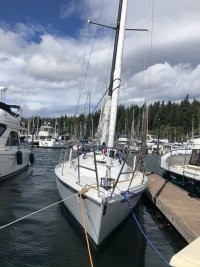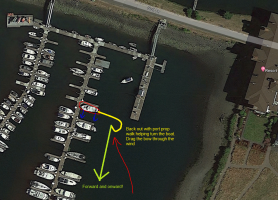Ever pull into or out of an unfamiliar marina with conditions that are less than ideal or favorable? In this first post, we look at planning for exiting a dock and marina in unfavorable conditions, and planning to essentially make those conditions viable and safe.
Common Questions
Given these wind conditions, How should I get off the dock?
How could I have managed my route planning better?
Here's what went wrong on my last trip, How should I handle it differently in the future?
-------------------
We got a late start on our 60nm trip from Alderbrook to Everett, so we decided to stop in Port Ludlow for the night instead of pushing it and having to arrive in Everett after sunset. The problem was the wind was forecasted to be 15-25knots the following day and we would either have to fight an ebb tied with the wind, or take advantage of the flood at the cost of a wind against tide situation. I knew this going into the decision, but what I didn't consider was the difficulty of getting off the dock at Port Ludlow. The situation:
20-25knot wind pinning us to the dock
Stern in
Boat pulls to port in Reverse, negligible pull to Starboard in forward

Concerns:
I didn't know if I could turn the bow into the wind using the rudder under way, prop wash, or prop walk before drifting into the docks down wind.
Solution we used.
We used bow and stern lines to handline the boat over to the adjacent dock. This had the advantage of the wind pull us off the dock and provided a point where we could use a spring line on the bow to keep the bow into the wind. we looped the bow line and aft spring line over the front of the dock cleat. My wife handled the bow line and I handled the spring line. I moved the rudder hard over to starboard, put it in gear, and eased off on the spring line while my wife held the bow line. The stern drifted down wind, the bow stayed put, and the boat came around into the wind. We exited the slip, both lines came off the front horns of the cleats, and we pulled the line into the boat to ensure the did not get pulled into the prop.
Hind Site.
This worked really well, but I did feel a bit silly handlining the boat over to the adjacent dock and It did rely on the slip being empty. There was also a risk of the lines getting fowled in the prop even through we mitigated it by looping them over the horn and taking care to keep the tail on the boat and pulling them in as soon as they were clear. We thought the worst that could happen is we would drift back to the slip we originally started from.
This could have been avoided by going straight to Everett the previous day, docking in the other slip the night before, or spending an additional night in Port Ludlow (Of course we had plans the following day that I didn't want to cancel).
Questions:
What would others have done?
is handlining a boat a "seamanship" thing to do?
Would I have had any chance to keep the bow into the wind?
Should I have gone down wind then reversed out?
Additional thoughts:
The decision to stop in Port Ludlow proved to be a poor one as the wind ended up being worse than forcasted. I made it even worse by delaying departure from Port Ludlow until after the tide sifted which resulted in going in a wind against tide situation. It turned out to be the roughest crossing we've ever done. There's quite a bit more to consider and it would take a while to post all variables which is why I decided to ask about the dock departure instead of the trip planning.
Here's an Instagram post from Sailbainbridge of the conditions (I was unwilling to take my hands off the wheel long enough to video our crossing):

 www.instagram.com
www.instagram.com
Common Questions
Given these wind conditions, How should I get off the dock?
How could I have managed my route planning better?
Here's what went wrong on my last trip, How should I handle it differently in the future?
-------------------
We got a late start on our 60nm trip from Alderbrook to Everett, so we decided to stop in Port Ludlow for the night instead of pushing it and having to arrive in Everett after sunset. The problem was the wind was forecasted to be 15-25knots the following day and we would either have to fight an ebb tied with the wind, or take advantage of the flood at the cost of a wind against tide situation. I knew this going into the decision, but what I didn't consider was the difficulty of getting off the dock at Port Ludlow. The situation:
20-25knot wind pinning us to the dock
Stern in
Boat pulls to port in Reverse, negligible pull to Starboard in forward

Concerns:
I didn't know if I could turn the bow into the wind using the rudder under way, prop wash, or prop walk before drifting into the docks down wind.
Solution we used.
We used bow and stern lines to handline the boat over to the adjacent dock. This had the advantage of the wind pull us off the dock and provided a point where we could use a spring line on the bow to keep the bow into the wind. we looped the bow line and aft spring line over the front of the dock cleat. My wife handled the bow line and I handled the spring line. I moved the rudder hard over to starboard, put it in gear, and eased off on the spring line while my wife held the bow line. The stern drifted down wind, the bow stayed put, and the boat came around into the wind. We exited the slip, both lines came off the front horns of the cleats, and we pulled the line into the boat to ensure the did not get pulled into the prop.
Hind Site.
This worked really well, but I did feel a bit silly handlining the boat over to the adjacent dock and It did rely on the slip being empty. There was also a risk of the lines getting fowled in the prop even through we mitigated it by looping them over the horn and taking care to keep the tail on the boat and pulling them in as soon as they were clear. We thought the worst that could happen is we would drift back to the slip we originally started from.
This could have been avoided by going straight to Everett the previous day, docking in the other slip the night before, or spending an additional night in Port Ludlow (Of course we had plans the following day that I didn't want to cancel).
Questions:
What would others have done?
is handlining a boat a "seamanship" thing to do?
Would I have had any chance to keep the bow into the wind?
Should I have gone down wind then reversed out?
Additional thoughts:
The decision to stop in Port Ludlow proved to be a poor one as the wind ended up being worse than forcasted. I made it even worse by delaying departure from Port Ludlow until after the tide sifted which resulted in going in a wind against tide situation. It turned out to be the roughest crossing we've ever done. There's quite a bit more to consider and it would take a while to post all variables which is why I decided to ask about the dock departure instead of the trip planning.
Here's an Instagram post from Sailbainbridge of the conditions (I was unwilling to take my hands off the wheel long enough to video our crossing):

S A I L • B A I N B R I D G E /// Capt Ben Doerr on Instagram: "Rough and rowdy ride down the backside of Whidbey today. The Salish Sea sure was in a mood. But our steady ship performed brilliantly and was quite comfortable even through the worst of
193 likes, 16 comments - sailbainbridge on April 8, 2023: "Rough and rowdy ride down the backside of Whidbey today. The Salish Sea sure was in a mood. But our steady ship performed brilliantly and..."
 www.instagram.com
www.instagram.com
Last edited by a moderator:




